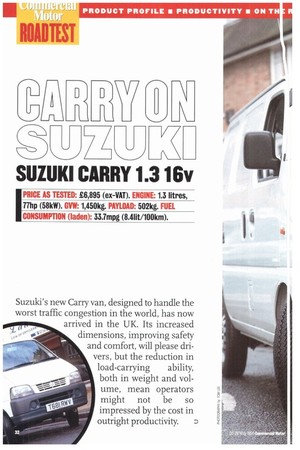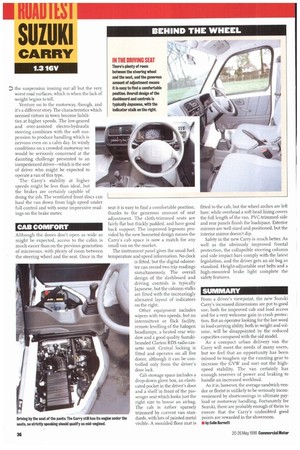SUZUKI CARRY 1.3 16v
Page 34

Page 36

Page 38

If you've noticed an error in this article please click here to report it so we can fix it.
'PRICE AS TESTED: 16,895 (ex-VAT). ENGINE: 1.3 litres, 77hp (58kW). GVW: 1,450kg. PAYLOAD: 502kg. FUEL CONSUMPTION (laden): 33.7mpg (8.411t/100km).
Suzuki's new Carry van, designed to handle the worst traffic congestion in the world, has now arrived in the UK. Its increased dimensions, improving safety and comfort, will please drivers, but the reduction in load-carrying ability, both in weight and volume, mean operators might not be so impressed by the cost in
outright productivity. 0 nyone who thinks British roads are crowded should try Tokyo and other major Japanese cities. There, compact vans are not just a handy aid to easy parking, but an essential way of cramming more vehicles into each mile of road space. As a result, japan has developed a vehicle category which is becoming increasingly relevant in the West.
Microvans (and pickups) have featured in the UK for nearly two decades, with Daihatsu and Suzuki (also sold behind various General Motors badges) the major players. Although sales have satisfied the needs of various niche markets, there has always been a perception that the safety of these lightweight, flat-nosed vehicles is somewhat compromised. Now Suzuki has taken the basic concept and, with a stretch here and a bulge there, redefined the category, answering safety doubts in the process.
PRODUCT PROFILE
The Suzuki Carry, launched at the Brussels Motor Show in January, effectively moves the microvan market up half a size. The allnew styling, which now gives the van the "one-and-a-half-box" appearance shared by most current 3.5-tonners, has the essential extra benefit of creating some crumple space between the driver and the hostile world in front.
The Suzuki Carry range in the UK is easy to describe, with one model—the panel van; one colour—white: and no factory options. Other versions, including a pickup, are available in Japan, but Suzuki has no plans to extend the range here in the immediate future.
Although it looks as if its layout is conventional, the Carry still has its engine under the seats, which, strictly speaking, should qualify it as mid-engined. The space under the bonnet contains nothing more than a few fluid reservoirs, the jack and the steering rack, but it is a pity it has no floor, as this could be a useful extra storage area.
The engine is a lightweight four-cylinder petrol unit of 1,298cc capacity with alloy head and block, producing 77hp (58k'W) at a rather high 5 ,7oorpm. The 16 valves are operated by single overhead camshaft, and fuel and sparks are delivered by electronic multi-point injection and a solid-state "distributor-less" ignition system.
Transmission is through a five-speed gearbox to a live coil-sprung rear axle, while the front end has McPherson struts. The
brakes are ventilated discs at the front, and drums at the rear.
PRODUCTIVITY
Access to the load space couldn't be easier: with two side-loading doors and a tailgate-type rear door, the whole floor area can be reached without a stretch. The test van arrived without any bulkhead or tie-down points, but Suzuki assures us that customer vehicles will have lashing rings and that a bulkhead will be available as an option. But if you value the back of your head, check when you buy.
Although the new van's gross weight has increased by 4 okg to 1,45 okg, the kerbweight with a 75kg driver on board has jumped from 86o to 948kg. As a result, the usable payload has fallen by 48kg. Likewise, although the external dimensions are greater all round, the benefits are found in cabin accommodation rather than increased loadspace: the load deck length has actually been reduced by 270mm.
To provide a flat load floor, Suzuki's designers have built the floor above wheelarch level, giving a loading level at a back-friendly 743mm above the ground, nearly 2001T1IT1 higher than the old model. A corollary of the high floor is an extra underfloor space the width of the side doors and stretching fully from side to side. No floor mat is provided, which means that the large bolt head protruding from the middle of the loadspace could damage vulnerable loads.
If the loading height is kind to glass backs, the knee-height fuel filler behind the driver's door more than compensates. Fortunately the 40-litre tank fills quickly, lessening the discomfort. We obtained a laden fuel consumption figure of 33.7mpg around our Kent test route—slightly better than that of its arch-rival from Daihatsu, but significantly down on the diesel-powered car-derived opposition in the same price band. Unladen, things improved somewhat to 41.6mpg, but the Suzuki could do with a compact state-of-the-art diesel to really impress.
Daily maintenance checks are a bit of a fiddle, as most fluids are checked from under the bonnet, but the engine oil dipstick is located within the engine bay. Fortunately, gaining access to the engine bay is relatively easy, with two latches under each seat allowing the mounting panels to tip backwards, although a longer remote dipstick would be more convenient.
ON THE ROAD
Move away from rest in the Suzuki Carry, and it's soon apparent that its performance has grown in line with its dimensions. Despite high gearing, which means the 3 omph speed limit is reached in first gear and the motorway limit in third, acceleration is strong. Engine noise is a little intrusive under hard acceleration, but settles down to acceptable levels as speeds stabilise. As might be expected from a small, high-output petrol engine, the gearbox needs frequent stirring to obtain the best results, but the Carry will happily potter around town at low revs if speed is not so important. And it's around town that the van is at its best, nipping in and out of traffic with D
the suspension ironing out all but the very worst road surfaces, which is when the lack of weight begins to tell.
Venture on to the motorway, though, and it's a different story. The characteristics which seemed virtues in town become liabilities at higher speeds. The low-geared and over-assisted electro-hydraulic steering combines with the soft suspension to produce handling which is nervous even on a calm day. In windy conditions on a crowded motorway we would be seriously concerned at the daunting challenge presented to an inexperienced driver—which is the sort of driver who might be expected to operate a van of this type.
The Carry's stability at higher speeds might be less than ideal, but the brakes are certainly capable of doing the job. The ventilated front discs can haul the van down from high speed under full control and with some impressive readings on the brake meter.
CAB COMFORT
Although the doors don't open as wide as might be expected, access to the cabin is much easier than on the previous generation of microvans, with plenty of room between the steering wheel and the seat. Once in the seat it is easy to find a comfortable position, thanks to the generous amount of seat adjustment. The cloth-trimmed seats are fairly flat but thickly padded, and have good back support The improved legroom provided by the new bonneted design means the Carry's cab space is now a match for any small van on the market.
The instrument panel gives the usual fuel, temperature and speed information. No dock is fitted, but the digital odometer can record two trip readings simultaneously. The overall design of the dashboard and driving controls is typically Japanese, but the column stalks are fitted with the increasingly alienated layout of indicators on the right.
Other equipment includes wipers with two speeds, but no intermittent or flick facility, remote levelling of the halogen headlamps, a heated rear window and a good quality Suzukibranded Clarion RDS radio cassette unit. Central locking is fitted and operates on all five doors, although it can be controlled only from the driver's door lock.
Cab stowage space includes a drop-down glove box, an elasticated pocket in the driver's door and a shelf in front of the passenger seat which looks just the right size to house an airbag. The cab is rather sparsely trimmed by current van standards, with lots ofpainted metal visible. A moulded floor mat is fitted to the cab, but the wheel arches are left bare, while overhead a soft head lining covers the full length of the van. PVC-trimmed side and rear panels finish the loadspace. Exterior mirrors are well sized and positioned, but the interior mirror doesn't dip.
Safety in the new Carry is much better. As well as the obviously improved frontal protection, the collapsible steering column and side impact bars comply with the latest legislation, and the driver gets an air bag as standard. Height-adjustable seat belts and a high-mounted brake light complete the safety features.
SUMMARY
From a driver's viewpoint, the new Suzuki Carry's increased dimensions are put to good use, both for improved cab and load access and for a very welcome gain in crash protection. But an operator looking for the last word in load-carrying ability, both in weight and volume, will be disappointed by the reduced capacities compared with the old model.
As a compact urban delivery van the Carry will meet the needs of many users, but we feel that an opportunity has been missed to toughen up the running gear to increase the GVW and sort out the highspeed stability. The van certainly has enough reserves of power and braking to handle an increased workload.
As it is, however, the average sandwich vendor or florist is unlikely to be seriously inconvenienced by shortcomings in ultimate payload or motorway handling. Fortunately for Suzuki, there are probably enough of them to ensure that the Carry's undoubted good points are rewarded in the showroom.
• by Colin Barnett
SUZUKI
CARRY
SPECIFICATION
MODEL
Suzuki Carry t3 16v.
Design Mt 1,450kg.
Importer: Suzuki GB, 46-62 Gatwick Road, Crawley, West Sussex RH10 2XF.
ENGINE
Suzuki G13B0 16-valve SOHC, watercooled with multi-point electronic fuel injection, mounted beneath seats. Cylinders; Four, in-line, Bore/stroke: 74x75.5mm.
Capacity: 1,298cc.
Compression ratio: 9.5:1.
Maximum net power: 77hp (58kW) at 5,700rpm.
Maximum net torque: 101Nm (75Ibft) at 3,000rpm.
TRANSMISSION
Five-speed synchromesh gearbox driving rear wheels.
Rats& 3.652,2.25,1.473,1,0 and 0.7951; reverse, 3.456;1.
Real drive: 4.30:1.
Clutch: Single dry plate.
BAKING SYSTEM
Dual-circuit servo-assisted hydraulic system with front-ventilated discs and rear drums. Load-sensing apportioning valve. Cable-operated parking brake acting on rear wheels. Braltriirminskins: Front, 231mm; rear, 220mm.
STEERING
Electro-hydraulic power-assisted rack and pinion.
CHASSIS
Steel unitary construction tine-door panel van.
Suspension: Front, MacPherson struts and anti-roll bar; rear, live axle located by trailing arms and Panhard rod, with concentric coil spring/ damper units.
Axle design welts; Front, 700kg; rear; 930kg.
Design EIW: 2,550kg; maximum braked trailer weight, 1,100kg. Wheels and tyres:13in steel wheels with 155013 tyres.
Fuel tank: 40 litres.
ELECTRICAL SYSTEM
Battery:12V,140Ah. Generator: 60A.
TERMS OF WARRANTY
Three-year or 60,000-mile mechanical and paint warranty. One year's roadside assistance and recovery. Six-year anti-corrosion warranty.
DEALERS AND SERVICE POINTS
Suzuki has 140 dealers in the UK.




















































































































